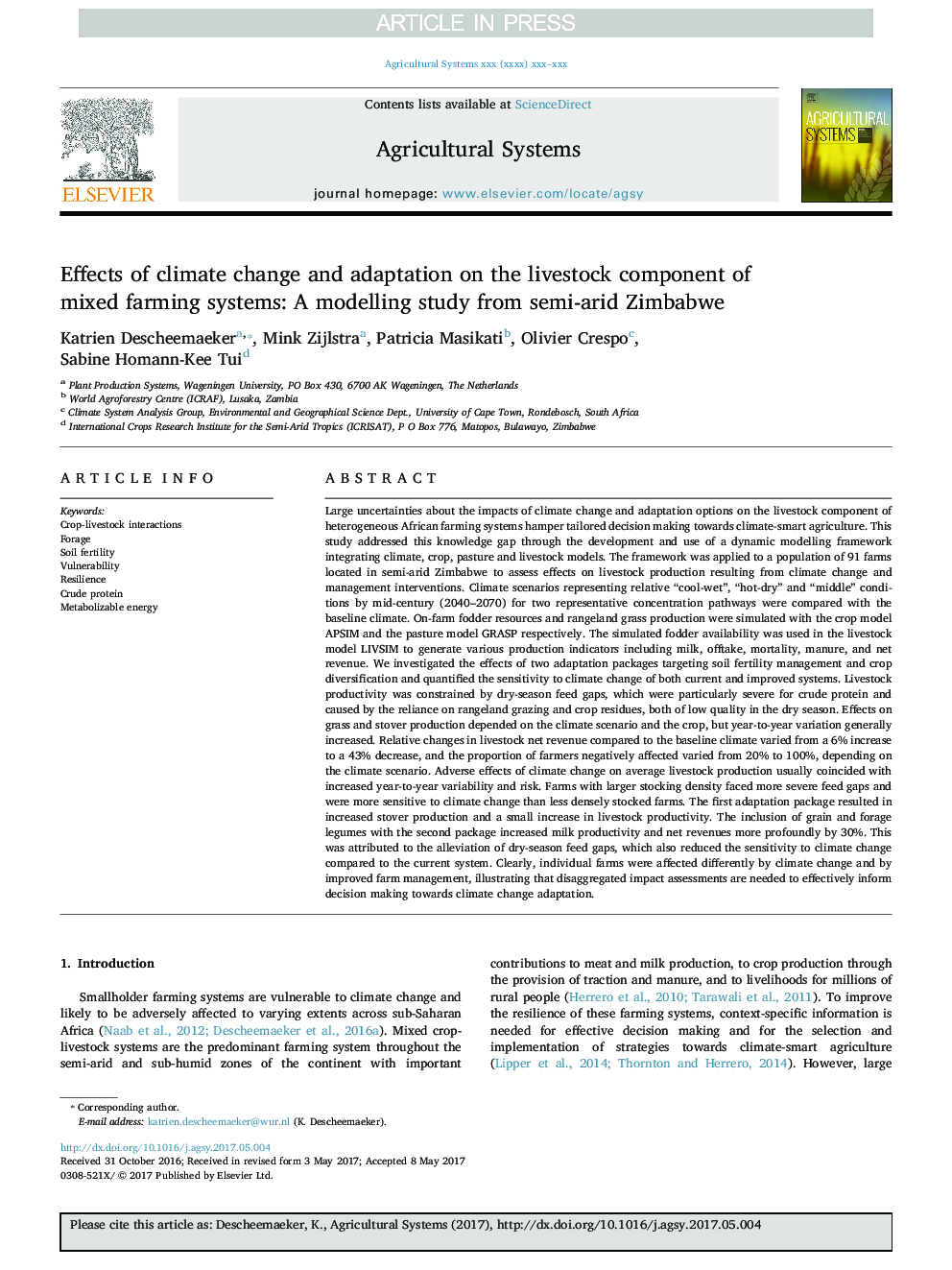| کد مقاله | کد نشریه | سال انتشار | مقاله انگلیسی | نسخه تمام متن |
|---|---|---|---|---|
| 8875099 | 1623211 | 2018 | 14 صفحه PDF | دانلود رایگان |
عنوان انگلیسی مقاله ISI
Effects of climate change and adaptation on the livestock component of mixed farming systems: A modelling study from semi-arid Zimbabwe
ترجمه فارسی عنوان
اثرات تغییرات آب و هوایی و سازگاری با مولفه های دام در سیستم های کشاورزی مختلط: یک مطالعه مدلسازی از نیمه خشک
دانلود مقاله + سفارش ترجمه
دانلود مقاله ISI انگلیسی
رایگان برای ایرانیان
کلمات کلیدی
تعاملات مزرعه علوفه، باروری خاک، آسیب پذیری، انعطاف پذیری، پروتئین خام انرژی متابولیزه کننده،
موضوعات مرتبط
علوم زیستی و بیوفناوری
علوم کشاورزی و بیولوژیک
علوم کشاورزی و بیولوژیک (عمومی)
چکیده انگلیسی
Large uncertainties about the impacts of climate change and adaptation options on the livestock component of heterogeneous African farming systems hamper tailored decision making towards climate-smart agriculture. This study addressed this knowledge gap through the development and use of a dynamic modelling framework integrating climate, crop, pasture and livestock models. The framework was applied to a population of 91 farms located in semi-arid Zimbabwe to assess effects on livestock production resulting from climate change and management interventions. Climate scenarios representing relative “cool-wet”, “hot-dry” and “middle” conditions by mid-century (2040-2070) for two representative concentration pathways were compared with the baseline climate. On-farm fodder resources and rangeland grass production were simulated with the crop model APSIM and the pasture model GRASP respectively. The simulated fodder availability was used in the livestock model LIVSIM to generate various production indicators including milk, offtake, mortality, manure, and net revenue. We investigated the effects of two adaptation packages targeting soil fertility management and crop diversification and quantified the sensitivity to climate change of both current and improved systems. Livestock productivity was constrained by dry-season feed gaps, which were particularly severe for crude protein and caused by the reliance on rangeland grazing and crop residues, both of low quality in the dry season. Effects on grass and stover production depended on the climate scenario and the crop, but year-to-year variation generally increased. Relative changes in livestock net revenue compared to the baseline climate varied from a 6% increase to a 43% decrease, and the proportion of farmers negatively affected varied from 20% to 100%, depending on the climate scenario. Adverse effects of climate change on average livestock production usually coincided with increased year-to-year variability and risk. Farms with larger stocking density faced more severe feed gaps and were more sensitive to climate change than less densely stocked farms. The first adaptation package resulted in increased stover production and a small increase in livestock productivity. The inclusion of grain and forage legumes with the second package increased milk productivity and net revenues more profoundly by 30%. This was attributed to the alleviation of dry-season feed gaps, which also reduced the sensitivity to climate change compared to the current system. Clearly, individual farms were affected differently by climate change and by improved farm management, illustrating that disaggregated impact assessments are needed to effectively inform decision making towards climate change adaptation.
ناشر
Database: Elsevier - ScienceDirect (ساینس دایرکت)
Journal: Agricultural Systems - Volume 159, January 2018, Pages 282-295
Journal: Agricultural Systems - Volume 159, January 2018, Pages 282-295
نویسندگان
Katrien Descheemaeker, Mink Zijlstra, Patricia Masikati, Olivier Crespo, Sabine Homann-Kee Tui,
